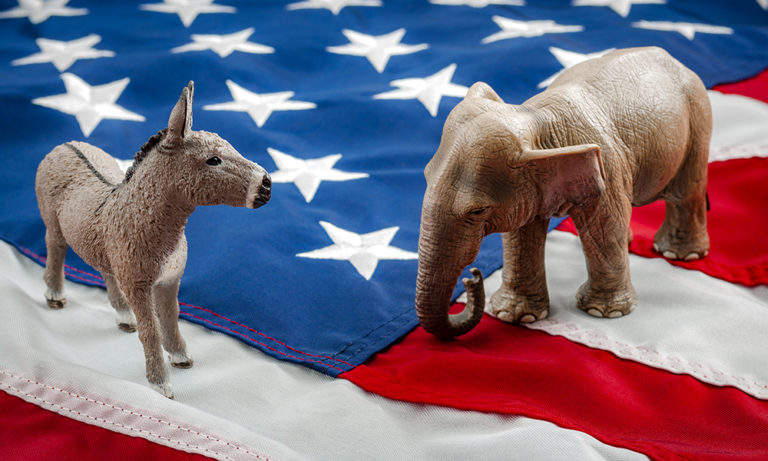
What An Election Does to Stocks
What happens to the economy when a president is elected or reelected? The answer may surprise you.
S&P 500 Per Presidential Term
Since 1952, when Eisenhower was first elected, the price change of the S&P 500 has been positive every presidential term except three.
S&P 500 Price Change by Presidential Term1
| Eisenhower 1 (R) | up 70.7% |
| Eisenhower 2 (R) | up 34.3% |
| Kennedy-Johnson (D) | up 44.3% |
| Johnson 2 (D) | up 17.4% |
| Nixon 1 (R) | up 16.8% |
| Nixon 2 – Ford (R) | down 13.3% |
| Carter (D) | up 27.9% |
| Reagan 1 (R) | up 30.1% |
| Reagan 2 (R) | up 67.3% |
| Bush (R) | up 51.2% |
| Clinton 1 (D) | up 79.2% |
| Clinton 2 (D) | up 72.9% |
| Bush 1 (R) | down 12.5% |
| Bush 2 (R) | down 31.5% |
| Obama 1 (D) | up 84.5% |
| Obama 2 (D) | up 52.9% |
| Trump (up to 10/29/2020) (R) | up 46.2% |
S&P 500 In Election Years
But what about election years? This question may matter more if you are planning to retire in the next year or two. Can you expect to see an upturn or downturn in the markets?
Since 1928, every election year has resulted in an upturn for the market except four times. Those downturn years were 1932 (-8.2%) when FDR was first elected, 1940 (-9.8%) when FDR was elected a third time, 2000 (-9.1%) when George W. Bush was first elected, and 2008 (-37.0%) when Obama was first elected.2
Excluding FDR’s reelection, the election years that resulted in negative returns occurred alongside a party change in the White House. That’s not to say a party change always results in a downturn, but examining each year a downturn happened during an election year brings about interesting conclusions.
1932: FDR was first elected during the Great Depression, which worked hand-in-hand with defeating Hoover as the incumbent president to bring about a downturn in the S&P.
1940: Though America had not yet entered WWII, global war had broken out the year before, and lots of uncertainty accompanied FDR’s unprecedented third term as president.
2000: Following on the heels of a dot-com bubble, Bush narrowly won against Gore in a controversial election that shifted power away from Democrats after eight prosperous years under Clinton.
2008: Obama’s first victory turned the White House blue again in the middle of one of the biggest financial crises in our nation’s history.
What do these years have in common? The downturns in the market during election years had an obvious explanation that had little to do with the presidential election. Whether financial, global unrest, or controversial elections, all of them stirred up uncertainty for investors that lead to a slope in the S&P.
What About 2020?
If you’re like most people, you’ll agree 2020 has felt like a year of uncertainty. The markets have been boosted because of the stimulus, but there are no promises yet for another stimulus.
No one knows the future (though it’d be nice if we did!). However, with an election to help wrap up the year along with a pandemic, stimulus bills, and civil unrest, it seems there are many factors that could impact the market.
Keep in mind, past results do not guarantee future performance. With that said, in an uncertain environment, it can be beneficial to speak with a financial professional.
Sources:
1: https://www.investopedia.com/presidents-and-their-impact-on-the-stock-market-4587369 Accessed 11/2/2020 (Reference: Investopedia “Presidents and the Stock Market”)
2: https://www.thebalance.com/presidential-elections-and-stock-market-returns-2388526
1394313-1121
Share This Article
Read The Previous Article
Read The Next Article
October 27, 2020
Happy Halloween! 3 Not-So-Scary Retirement Facts
November 11, 2020